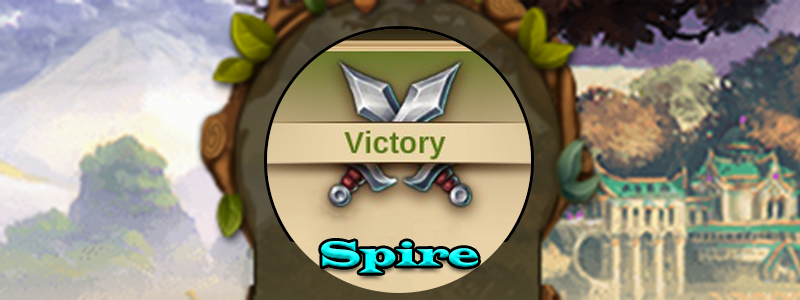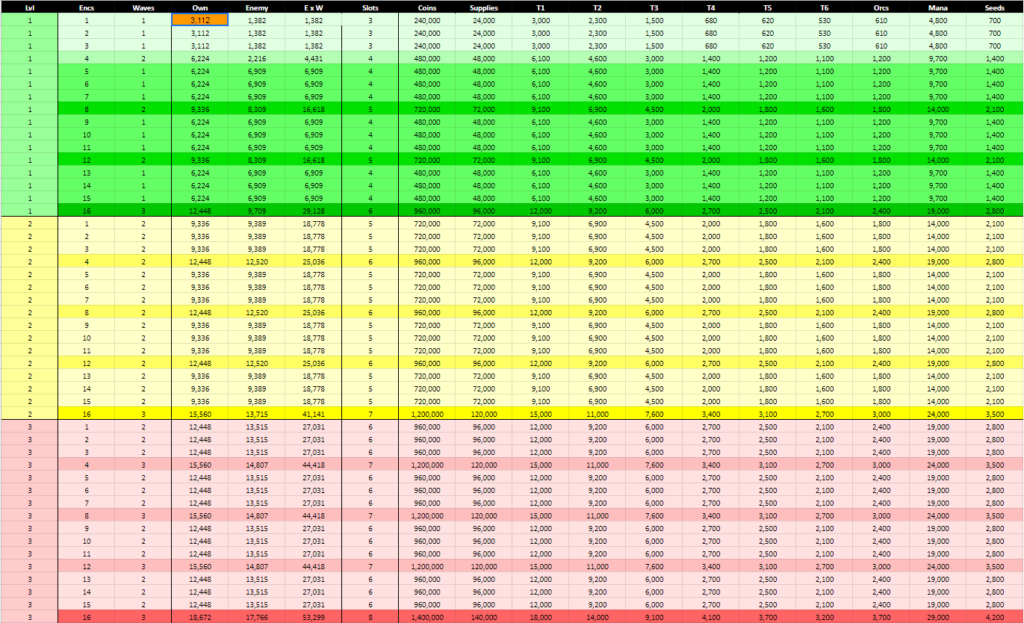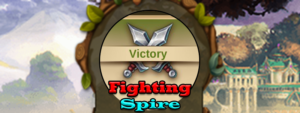[2020-08-26] Spire Progression Model outlines how Spire of Eternity requirements – squad sizes and negotiation costs – evolve as you go higher in the Spire and do more encounters. There are some major changes being proposed to the tournament structure (Summer 2020), and it also has impact on the Spire as both features are closely integrated now from the modeling perspective. This post describes how Spire progression works.
Table of Contents
* – * – *
For a particular encounter in the Spire, enemy squad size always has the same ratio to your own squad size. And similar to that, your own squad size progression is also fixed. So all squad sizes in later encounters are completely determined by your own squad size at the very first encounter – which in turn is completely determined by CAL (City Advancement Level). And the same again goes for negotiation costs. Basically, once your weekly Spire is instantiated the whole setup can be represented by a single CAL number. Everything else will always be fixed with respect to that.
And just like with the new tournaments, once Spire has started, its parameters are fixed. Data snap seems to be very close to the time the Spire starts, and so far it seems that it is different from the tournament’s. This means that if you make some changes between the Spire start and tournament start, it will be reflected in the weekly tournament progression, but not in the Spire (as it would be fixed by then).
Encounter Progression
And this is how encounter progression looks like. Here it is:
Left side with Spire level, encounter number and number of waves is self-explanatory. Number of slots on the right is also straightforward – it’s the number of choices if you want to negotiate rather than fight.
‘Own’ column is your own Spire squad size for a particular encounter, expressed as a factor of the base Spire squad size (your first encounter Spire squad size).
‘Enemy’ column is your enemy‘s Spire squad size for a particular encounter, expressed as a factor of the base Spire squad size (your first encounter Spire squad size).
‘E x W’ column is a product of enemy squad size and a number of waves, as you’ll have to fight that many more enemy troops.
Example
So as an example, if your base Spire squad size (your own Spire squad size at the first encounter) is 1,000, you can quickly figure out what your final boss requirements are going to be. You will need to field 6,000 troops against 3 waves of ~5700 enemy troops, or 17,000+ enemies in total. This is going to be a tough fight 😉
Catering Costs
Now, Spire catering costs at any encounter are completely determined by your own squad size at that encounter. New tournaments are the same in this respect. Here is how individual goods factors look like:
Basically, if your squad size for a particular encounter is 1,000, this would mean that individual gold requirements would be 77.5K, supplies 7.5K, ~1K of T1 etc. The game will round these goods numbers in a particular way around that.
The relative costs of goods is actually the same as in the new tournaments. The factors differ by a fixed 3.33x (higher in the tournament), meaning that for the same squad size in Tournament and in the Spire, Tournament catering requirements will be 3.33x times higher.
Depending on where in chapters you are, you may not get all the variants. E.g. you won’t be seeing seeds before Halflings etc, but the factors do not change with chapter progression.
CAL Relationship
OK, so far there is nothing particularly new here comparing to the previous editions, just changes to some numerical parameters. Everything described so far is pinned on the base squad size (own squad size at the first encounter) as it is more familiar, and own SS multipliers look easier on the eyes. But how does this connect with CAL?
Well, the relationship is very simple – base Spire squad size (SSSo) is just a factor away from CAL. Like so:
SSSo is already basically a multiplier to everything in the tournament progression model (e.g. everything is pinned to that). And this simple factorization means that just as well CAL is a multiplier to everything in the Spire progression model. This means that as long as you’re doing the same number of encounters, all your troops used, losses and catering costs – in individual encounters and in total – will be proportional to CAL.
So you’ve done some research, placed some expansions and/or added some AW levels that increased your CAL by 10%? This would mean your troop losses and catering costs for the same Spire progress will increase by 10%. It is as simple as that. So now you can go back to the CAL model and see how individual inputs there will impact your Spire requirements.
And tournament requirements work the same. This means 10% CAL increase will add 10% to your costs for both Spire and tournaments.
Spire Progression Calculator
There is a full Tournament and Spire Requirements Calculator in the main post here:
You can use it to see a full Spire requirements progression based on fundamental factors. But you can also use it to look at the progression requirements based on your own base Spire squad size (at the first encounter). This is useful if CAL calculation is off for whatever reason (e.g. there were some changes etc).
So in order to do that you will need to go to the SpireCalc sheet (after cloning the document), then populate your base Spire squad size (orange cell) directly:
Keep in mind, that base SSS does not have to be a whole integer. So for extra accuracy for your real data you may want to use your max factor encounter data (usually, the toughest boss fight). Just divide your squad size there by the own SS factor,and put this number in the orange cell. E.g. if your SSS in the final boss fight on Level 2 is 15,012, then the game will show you 3,002 or 3,003 as your squad size in the first encounter, but that won’t be accurate. You should use 15,012/5 = 3,002.4 as your base SSS.
The same applies to SSSo cells in CALCalc sheet.
And that’s pretty much it 😉






![Read more about the article Elvenar Woodelves – Day 17 [54%]](https://minmaxgame.com/wp-content/uploads/2019/03/WoodelvesFeaturedD17-300x113.png)
![Read more about the article Elvenar Woodelves – Day 22 [65%]](https://minmaxgame.com/wp-content/uploads/2019/03/WoodelvesFeaturedD22-300x113.png)
![Read more about the article Elvenar Orcs – Day 33 [89%]](https://minmaxgame.com/wp-content/uploads/2019/03/OrcsFeaturedD33-300x113.png)

![Read more about the article Elvenar Sorcerers & Dragons – Day 24 [71%]](https://minmaxgame.com/wp-content/uploads/2019/04/SDFeaturedD24-300x113.png)
![Read more about the article Elvenar Orcs – Day 31 [81%]](https://minmaxgame.com/wp-content/uploads/2019/03/OrcsFeaturedD31-300x113.png)
In which blog do you first define CAL ?
https://minmaxgame.com/city-advancement-level-model-2020/